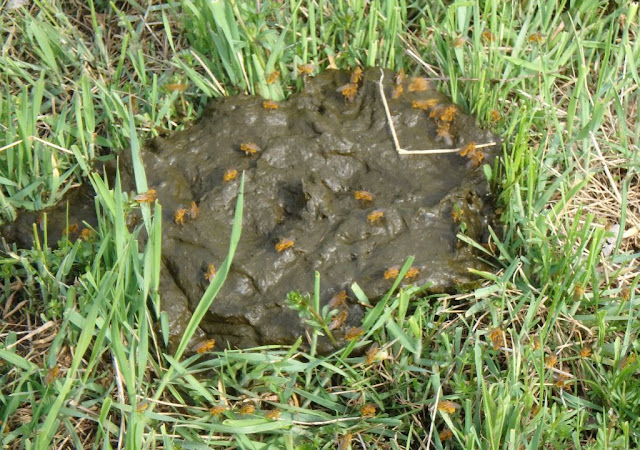The cattle spent more than two weeks in the north field. That's six large cows on nine acres, keeping down the vegetation while allowing the grass in the larger south field to recover a bit:
I have been carrying them out bowls of grain twice a day. This was a morning feeding as the sun was behind us, in the east:
They were in the north field when the Shadbush began to bloom in the woods behind the field:
Gracie appears to not be pregnant although I've certainly been fooled before. I wouldn't want to breed her now anyway because the calf would be born in the worst of winter. So I wait and watch:
I carried them over a trace mineral salt block but they didn't have access to granular minerals in the north field. To handle that problem, I began sprinkling the minerals on their bowls of grain before carrying them over:
And there's a hundred gallon stock tank in the north field, fed with fresh water from the barn via a pipe under the road. I have to turn on the water inside the barn and then run over to the door to watch so I can turn it off before it overflows. As you might guess, I've forgotten a few times and soaked the ground around the stock tank:
Another morning shot, with the rosy light of dawn illuminating their red coats:
And the chickens try to steal whatever grain they can. The cows usually don't allow that but they do spill grain while eating and the chickens make sure none of that is wasted:
A peaceful scene, and a popular one with local people driving on the gravel road. The cattle are close to the road and I see lots of people slow down or stop for a better look:
Scarlett had to defend her grain from ravenous chickens:
But Rosella was too lazy even to stand up. I carried her bowl over and set it down where she could reach it. Gee, you don't suppose these cows are spoiled, do you?
And to end this post on a gross note, here's part of raising cattle - Yellow Dung Flies. They show up wherever cow manure is found and I looked them up to learn about them. They live mostly on smaller insects but also consume nectar and dung. The males spend most of their lives on dung but the females forage for small insects on vegetation, returning to the dung to mate and to deposit their eggs. The larvae begin their lives eating the dung. For all their gross appearance to us, they are an important part of the balance of nature:













No comments:
Post a Comment
Note: Only a member of this blog may post a comment.